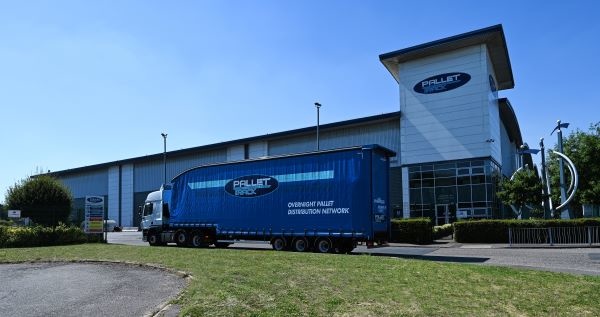
What is a Pallet Network?
09 Apr 2024
Published in: Member News
: How can a pallet network help your business? Learn how a hub and spoke distribution model can efficiently collect and deliver your palletised goods.
What is a pallet network?
A pallet network is made up of independent hauliers who work together to transport palletised goods in an efficient and cost-effective way.
Pallet networks like Pallet-Track use a hub and spoke distribution model to collect, sort and deliver goods around the country. Network members are located nationwide and are allocated a postcode area from which they collect and deliver palletised goods.
A hub and spoke logistics network connects its members via a single intermediary location. Here, the collected pallets are sorted and loaded for their onward journey to their destination, a process known as transhipment. Scanning and tracking technology is used to provide visibility of consignments from end to end.
Pallet-Track operates three of these intermediary locations. The first is our central hub in Wolverhampton, which covers 276,000 sq ft and has handled over 56 million pallets - never losing a single one! Our second hub covers 70,000 sq. ft and is located in Ashton-in-Makerfield, Wigan, while our third is based in Welwyn Garden City and covers 100,000 sq. ft. All locations were strategically selected for their proximity to the UK’s motorway network.
What does pallet delivery mean?
Pallet delivery is the process of collecting and moving goods that are secured to a pallet. These goods are typically heavy and bulky items that need to be manoeuvred by a pump truck or a forklift truck.
Transporting goods via a pallet makes it easier and more cost-effective for individual consignments to be transported without the need for a full load, making it effective for businesses that need to scale up or down to meet customer demand.
Safe transportation of consignments is essential, so wrapping is used to ensure goods are securely fixed to the pallet prior to collection and a safety assessment is completed at key stages of the journey.
The palletised method of transporting goods was originally developed to move goods for B2B – or business-to-business – customers. For example, components for manufacturing processes, aggregates for construction or wholesale goods for retail.
Pallet delivery has since been adopted for B2C – or business-to-consumer – purposes by retailers and ecommerce businesses selling heavy goods to customers, like tiles, turf or furniture. When delivering to residential addresses, kerbside delivery is used to ensure the safety of the delivery driver and the customer throughout the process.
How does pallet delivery work?
Every delivery that is made by a pallet network follows a similar process. To ensure consistent, high-quality service across our network and to maximise customer satisfaction, all our members follow the Pallet-Track Way.
Pallet delivery starts when goods are collected by one of our network members and transported to their depot for sorting and labelling, before their onward journey to the Pallet-Track hub.
At the hub, pallets are unloaded and sorted by postcode area before being loaded onto another network member’s truck for their onward journey – a process known as transhipment.
The pallets are sorted at the member’s depot before being transported to their destination.
Pallet-Track provides the benefit of pallet scanning and tracking throughout the journey. In fact, we scan every pallet nine times from collection to delivery, and our tracking is so sophisticated that we haven’t lost a single pallet at any of our hubs.
What are the advantages of a hub and spoke distribution model?
The main benefits of the hub and spoke distribution model used by pallet networks are that it increases vehicle fill and reduces the overall number of vehicles on the road due to the consolidation of freight.
According to research by the Association of Pallet Networks, the consolidation of freight using the hub and spoke logistics model increases average vehicle fill to 73%, compared to the logistics industry average of 51%.
In addition, pallet networks decrease the number of vehicles on the roads by an estimated 800 per day.
Optimised route planning and strategically located hubs help to speed up the delivery process, making hub and spoke logistics an ideal partner for businesses operating just-in-time supply chains and those with seasonal peaks. It is also a highly cost-effective model, as businesses do not need to operate their own fleet and they can improve delivery times while reducing transport costs.
At Pallet-Track, there are additional advantages to using our hub and spoke distribution service, such as our pallet scanning and tracking. We work collaboratively with our members to continually strengthen and improve our pallet network by investing in people, information technology, operational equipment and our hubs.
Speak to our team to find out how Pallet-Track's hub and spoke distribution model can support your business, improve efficiencies and help you to reduce emissions.
Which is the best pallet network operator?
There are many reasons why our approach to pallet delivery makes Pallet-Track the UK’s leading pallet network.
- We've been making pallets our priority for 20 years
- Our network is made up of more than 90 members across the UK
- Collectively, we have moved well over 56 million individual pallets
- 40 % of Pallet-Track members have been with our network for 15 years
- We use the most sophisticated pallet scanning and tracking process
- Our central hub handles 18,000 pallets per night and we haven’t lost a single one
- We support our members with their business growth strategies Talk to us today to find out how Pallet-Track can help your business.
Talk to us today to find out how Pallet-Track can help your business. Call us on 01902 355100
Comments
Post A Comment
You must be logged in to post a comment. Please click here to login.








